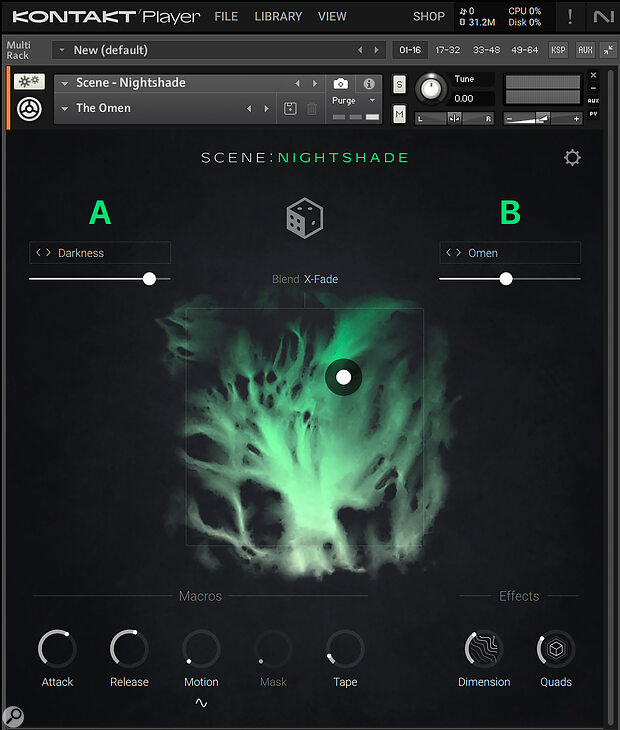Rating: ★ ★ ★ ★ ★ 5/5 Stars
When I first opened Nightshade, the third release in Native Instruments’ Scene series of cinematic sounds for media composers, the patch that loaded (seemingly randomly) was The Omen. A fitting start for an instrument filled with an abundance of ready‑to‑go creepy sounds at your fingertips.
A veritable all‑star ensemble of eerie sounds have gathered in this light‑on‑disk‑space (728.5MB) Kontakt 8 instrument: low rumbles, subliminal subs, baleful winds, breathy whispers, detuned notes, sharp scrapes, sinister organs, crackling transmission, ominous drones, granular voices and more. The groundwork for ghoulish score has been laid perfectly, straight out of the box, before you even begin to customise the settings to your taste.
The other impressive feature of the instrument is how easy it is to use while also allowing an enormous amount of flexibility. The core functionality is simple: each patch consists of two layered sounds, and adjustments are made via a large X/Y pad. Crossfade between the two sounds on the X axis; adjust modulation intensity on the Y axis. Both parameters are easily controlled through MIDI CC making it possible to modify sounds in real time, while playing.
Further fine‑tuning is possible with macros (Attack, Release, Motion, Mask, Tape) and effects, which come with creative names like Crushed Sky, Introspection and Double Ring but are in effect a function of simple or complex reverb, delay, degradation and modulation. The drop‑down menu for each individual sound allows you to select a scale and mode of your choice for the composition.
Poly Aftertouch‑enabled
Nightshade is polyphonic aftertouch‑enabled, so those with compatible MIDI controllers are in for a treat. You can adjust volume, tuning and motion for individual notes as you play, adding even more expression to your performance. Even for basic controllers, the patches respond very well to velocity sensitivity, which is great, say, for choosing if you want the sounds to slowly fade in and creep up on you, or attack immediately. Playing with release time is particularly satisfying in this instrument: sudden stops and starts lend the music an unpredictable, abrupt feeling that adds to the disquiet.
The sounds in Nightshade are spooky across the spectrum, and while billed as a horror instrument, I found it capable of quite nuanced dark compositions; there are varying levels of intensity, it’s not all jump scares. While dread, doom and otherworldly soundscapes are serviced well, there are some delightfully old‑school patches that bring to mind more subtle movie moments of suspense and rising tension that were scored orchestrally in old‑timey movies.
The patches span several octaves of playability, adding more colours to your palette. As they rise in pitch, the sounds gain texture and sometimes even movement. You’re not limited to a sweet spot for each patch, instead you can use the different colours of the low to high registers to shape the sound.
The instrument handles movement wonderfully with rhythmic pulses, jagged LFOs, and even what feels like triplets. It’s actually startling to realise that, in a horror context, a steady low tone has an air of despairing finality to it while a more kinetic, panned rumble promises escape for your protagonist. The darkness hasn’t taken root, you can still run! If you’re the type to yell at the screen, there’s a sound here that will inspire you to do that.
...this library is an absolute steal. It has great sounds out of the box, and the flexibility to customise them extensively.
At only £25 $29, this library is an absolute steal. It has great sounds out of the box, and the flexibility to customise them extensively. I can’t think of what else you might need to start setting a properly sinister mood.

